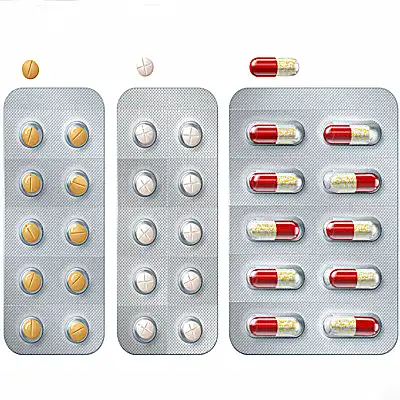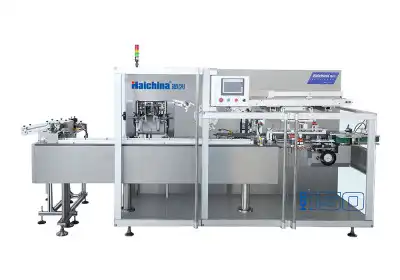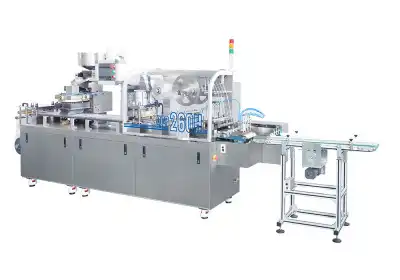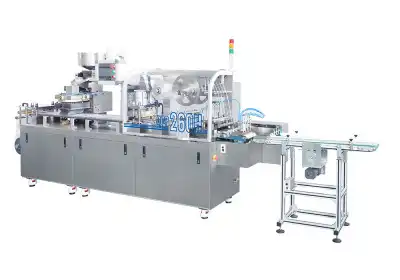Understanding Blister Packaging Technology in Pharmaceuticals
Types of Blister Packaging Machines
Blister packaging machines are available in several types to accommodate different pharmaceutical production requirements. Rotary blister machines are known for their high-speed output, making them ideal for large-scale manufacturing environments where efficiency is critical. Flat-plate blister machines offer greater versatility, suitable for smaller production batches and frequent format changes. Thermoforming machines use heat and pressure to mold plastic blisters, while cold-forming machines employ aluminum foil to provide exceptional moisture and oxygen barrier protection for sensitive drug formulations.
Components of a Blister Packaging System
A blister packaging machine consists of multiple coordinated components that work together to ensure accuracy and reliability. The forming station molds the blister cavities, creating precise pockets for each dose. The filling station deposits tablets, capsules, or ampoules into these cavities with exact positioning. Next, the sealing station uses controlled heat and pressure to bond the lidding material securely. The cutting unit then separates the individual blisters, while integrated inspection systems verify seal integrity, alignment, and product quality before final packaging.
Material Selection for Pharmaceutical Blister Packaging
Selecting appropriate materials for pharmaceutical blister packaging is essential to maintaining drug stability, safety, and compliance. PVC remains the most widely used material due to its clarity and cost-efficiency, while PVDC and COC films enhance moisture and oxygen resistance. Aluminum foil, often used as a lidding material, provides superior protection against light and environmental exposure. The choice of materials depends on factors such as the drug's chemical composition, required shelf life, and storage conditions, ensuring long-term preservation of product efficacy and safety.
Benefits and Applications of Blister Packaging in the Pharmaceutical Industry
Enhanced Product Protection and Shelf Life
Blister packaging provides a robust barrier against environmental factors that can degrade pharmaceutical products. The individual compartments protect each dose from moisture, light, and oxygen, significantly extending the shelf life of medications. This protection is particularly crucial for hygroscopic drugs or those sensitive to oxidation. The hermetic seal created by blister packaging machines ensures product integrity from manufacturing to patient use.
Improved Patient Compliance and Dosage Management
Unit-dose blister packaging facilitates better medication adherence among patients. Each blister contains a single dose, clearly labeled with important information such as drug name, dosage, and expiration date. This format simplifies dosage tracking and reduces the risk of accidental overdose. For healthcare providers, blister packaging enables efficient inventory management and reduces medication errors in clinical settings.
Tamper-Evidence and Product Authentication
Blister packaging machines incorporate features that make tampering evident, enhancing product safety and consumer confidence. The sealed nature of blisters makes it immediately apparent if a package has been compromised. Additionally, many pharmaceutical companies utilize blister packaging as a platform for implementing anti-counterfeiting measures, such as holograms or unique identifiers, to combat medication fraud and ensure product authenticity.
Innovations and Future Trends in Pharmaceutical Blister Packaging
Smart Packaging Technologies
The integration of smart technologies is revolutionizing blister packaging machine. RFID tags and NFC chips embedded in blister packs enable real-time tracking of medication usage and can send reminders to patients' smartphones. These innovations improve adherence monitoring and provide valuable data for healthcare providers. Some advanced systems even incorporate sensors to monitor environmental conditions, ensuring optimal drug storage throughout the supply chain.
Sustainable Packaging Solutions
Environmental concerns are driving the development of more sustainable blister packaging options. Biodegradable and compostable materials are being explored as alternatives to traditional plastics. Some manufacturers are focusing on minimizing packaging waste through optimized blister designs and the use of recycled materials. These eco-friendly approaches not only reduce environmental impact but also appeal to increasingly environmentally conscious consumers.
Customization and Flexibility in Packaging Design
Advancements in blister packaging machine technology are enabling greater customization and flexibility. Modular machine designs allow for quick changeovers between different product sizes and packaging formats. This adaptability is particularly valuable for contract manufacturers handling diverse product lines. Additionally, innovations in digital printing technologies are facilitating on-demand customization of blister packaging, allowing for personalized patient information or region-specific labeling without significant production delays.
Conclusion
Blister packaging machines have become indispensable in the pharmaceutical industry, offering unparalleled protection, convenience, and compliance benefits. As technology continues to evolve, these machines are poised to play an even more significant role in ensuring drug safety, enhancing patient experiences, and supporting sustainable packaging practices. The future of pharmaceutical packaging lies in smart, adaptable, and environmentally conscious solutions, with blister packaging machines at the forefront of this innovation.
FAQs
1. What are the main advantages of using blister packaging machines in pharmaceuticals?
Blister packaging machines offer enhanced product protection, improved patient compliance, tamper-evidence, and efficient unit-dose packaging.
2. Can blister packaging machines handle different types of medications?
Yes, modern blister packaging machines are versatile and can package various forms of solid medications, including tablets, capsules, and lozenges.
3. How do blister packaging machines contribute to medication safety?
These machines create individually sealed compartments, reducing the risk of contamination and providing clear labeling for each dose, which helps prevent medication errors.
Advanced Blister Packaging Solutions | Haichina
At Haichina, we specialize in manufacturing state-of-the-art blister packaging machines tailored for the pharmaceutical industry. Our equipment combines high-speed operation with precision, ensuring optimal protection for your products. We offer customizable solutions to meet specific packaging requirements, backed by our commitment to quality and innovation. For inquiries about our blister packaging machine solutions, contact our expert team at [email protected].
References
Johnson, M. (2022). Advances in Pharmaceutical Packaging Technology. Journal of Drug Delivery Science and Technology, 68, 103-115.
Smith, A., & Brown, B. (2021). Blister Packaging in the Pharmaceutical Industry: Current Trends and Future Prospects. International Journal of Pharmaceutics, 592, 120-132.
Lee, C. et al. (2023). Smart Packaging Technologies for Improved Medication Adherence. Drug Delivery and Translational Research, 13(2), 456-470.
Garcia, R. (2022). Sustainable Materials for Pharmaceutical Packaging: A Review. Packaging Technology and Science, 35(3), 201-215.
Williams, E., & Taylor, F. (2021). Quality Control in Pharmaceutical Blister Packaging: Best Practices and Emerging Technologies. PDA Journal of Pharmaceutical Science and Technology, 75(4), 321-335.
Chen, H. et al. (2023). Customization and Flexibility in Modern Pharmaceutical Packaging Equipment. International Journal of Industrial Engineering and Management, 14(1), 78-92.





